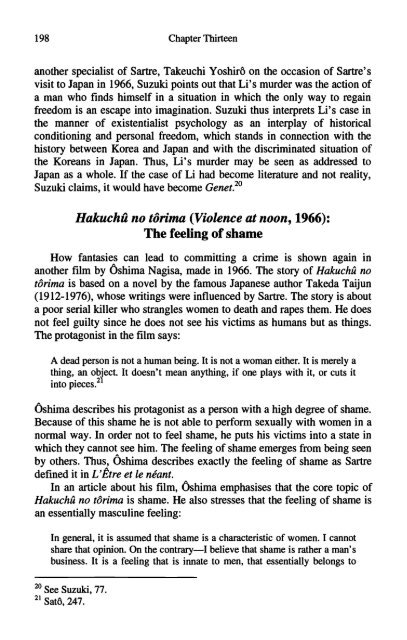Sartre's second century
Sartre's second century
Sartre's second century
You also want an ePaper? Increase the reach of your titles
YUMPU automatically turns print PDFs into web optimized ePapers that Google loves.
198 Chapter Thirteen<br />
another specialist of Sartre, Takeuchi YoshirS on the occasion of <strong>Sartre's</strong><br />
visit to Japan in 1966, Suzuki points out that Li's murder was the action of<br />
a man who finds himself in a situation in which the only way to regain<br />
freedom is an escape into imagination. Suzuki thus interprets Li's case in<br />
the manner of existentialist psychology as an interplay of historical<br />
conditioning and personal freedom, which stands in connection with the<br />
history between Korea and Japan and with the discriminated situation of<br />
the Koreans in Japan. Thus, Li's murder may be seen as addressed to<br />
Japan as a whole. If the case of Li had become literature and not reality,<br />
Suzuki claims, it would have become Genet. 20<br />
Hakuchu no torima (Violence at noon, 1966):<br />
The feeling of shame<br />
How fantasies can lead to committing a crime is shown again in<br />
another film by Oshima Nagisa, made in 1966. The story of Hakuchu no<br />
torima is based on a novel by the famous Japanese author Takeda Taijun<br />
(1912-1976), whose writings were influenced by Sartre. The story is about<br />
a poor serial killer who strangles women to death and rapes them. He does<br />
not feel guilty since he does not see his victims as humans but as things.<br />
The protagonist in the film says:<br />
A dead person is not a human being. It is not a woman either. It is merely a<br />
thing, an object. It doesn't mean anything, if one plays with it, or cuts it<br />
into pieces. 21<br />
Oshima describes his protagonist as a person with a high degree of shame.<br />
Because of this shame he is not able to perform sexually with women in a<br />
normal way. In order not to feel shame, he puts his victims into a state in<br />
which they cannot see him. The feeling of shame emerges from being seen<br />
by others. Thus, Oshima describes exactly the feeling of shame as Sartre<br />
defined it in VP.tre et le neant.<br />
In an article about his film, Oshima emphasises that the core topic of<br />
Hakuchu no torima is shame. He also stresses that the feeling of shame is<br />
an essentially masculine feeling:<br />
In general, it is assumed that shame is a characteristic of women. I cannot<br />
share that opinion. On the contrary—I believe that shame is rather a man's<br />
business. It is a feeling that is innate to men, that essentially belongs to<br />
20 See Suzuki, 77.<br />
21 Sat6, 247.
















